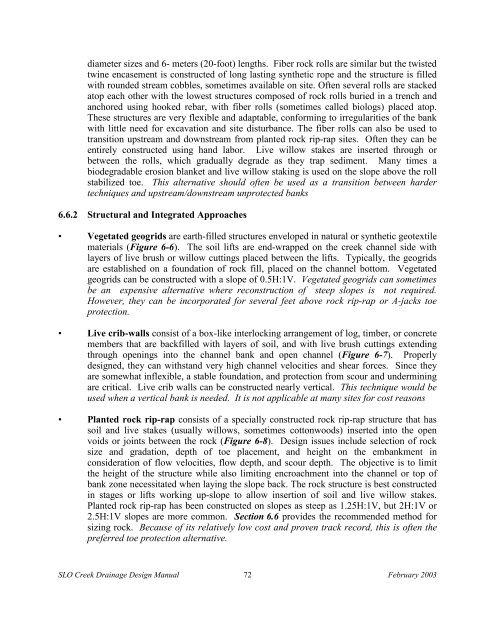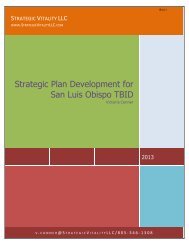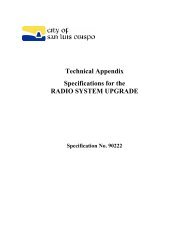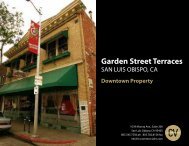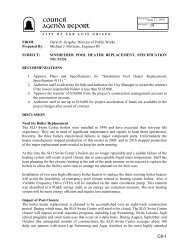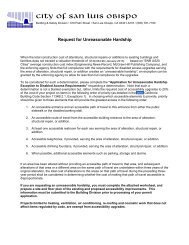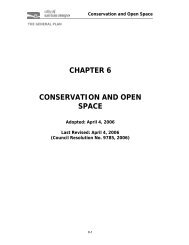Drainage Design Manual - the City of San Luis Obispo
Drainage Design Manual - the City of San Luis Obispo
Drainage Design Manual - the City of San Luis Obispo
You also want an ePaper? Increase the reach of your titles
YUMPU automatically turns print PDFs into web optimized ePapers that Google loves.
diameter sizes and 6- meters (20-foot) lengths. Fiber rock rolls are similar but <strong>the</strong> twistedtwine encasement is constructed <strong>of</strong> long lasting syn<strong>the</strong>tic rope and <strong>the</strong> structure is filledwith rounded stream cobbles, sometimes available on site. Often several rolls are stackedatop each o<strong>the</strong>r with <strong>the</strong> lowest structures composed <strong>of</strong> rock rolls buried in a trench andanchored using hooked rebar, with fiber rolls (sometimes called biologs) placed atop.These structures are very flexible and adaptable, conforming to irregularities <strong>of</strong> <strong>the</strong> bankwith little need for excavation and site disturbance. The fiber rolls can also be used totransition upstream and downstream from planted rock rip-rap sites. Often <strong>the</strong>y can beentirely constructed using hand labor. Live willow stakes are inserted through orbetween <strong>the</strong> rolls, which gradually degrade as <strong>the</strong>y trap sediment. Many times abiodegradable erosion blanket and live willow staking is used on <strong>the</strong> slope above <strong>the</strong> rollstabilized toe. This alternative should <strong>of</strong>ten be used as a transition between hardertechniques and upstream/downstream unprotected banks6.6.2 Structural and Integrated Approaches• Vegetated geogrids are earth-filled structures enveloped in natural or syn<strong>the</strong>tic geotextilematerials (Figure 6-6). The soil lifts are end-wrapped on <strong>the</strong> creek channel side withlayers <strong>of</strong> live brush or willow cuttings placed between <strong>the</strong> lifts. Typically, <strong>the</strong> geogridsare established on a foundation <strong>of</strong> rock fill, placed on <strong>the</strong> channel bottom. Vegetatedgeogrids can be constructed with a slope <strong>of</strong> 0.5H:1V. Vegetated geogrids can sometimesbe an expensive alternative where reconstruction <strong>of</strong> steep slopes is not required.However, <strong>the</strong>y can be incorporated for several feet above rock rip-rap or A-jacks toeprotection.• Live crib-walls consist <strong>of</strong> a box-like interlocking arrangement <strong>of</strong> log, timber, or concretemembers that are backfilled with layers <strong>of</strong> soil, and with live brush cuttings extendingthrough openings into <strong>the</strong> channel bank and open channel (Figure 6-7). Properlydesigned, <strong>the</strong>y can withstand very high channel velocities and shear forces. Since <strong>the</strong>yare somewhat inflexible, a stable foundation, and protection from scour and underminingare critical. Live crib walls can be constructed nearly vertical. This technique would beused when a vertical bank is needed. It is not applicable at many sites for cost reasons• Planted rock rip-rap consists <strong>of</strong> a specially constructed rock rip-rap structure that hassoil and live stakes (usually willows, sometimes cottonwoods) inserted into <strong>the</strong> openvoids or joints between <strong>the</strong> rock (Figure 6-8). <strong>Design</strong> issues include selection <strong>of</strong> rocksize and gradation, depth <strong>of</strong> toe placement, and height on <strong>the</strong> embankment inconsideration <strong>of</strong> flow velocities, flow depth, and scour depth. The objective is to limit<strong>the</strong> height <strong>of</strong> <strong>the</strong> structure while also limiting encroachment into <strong>the</strong> channel or top <strong>of</strong>bank zone necessitated when laying <strong>the</strong> slope back. The rock structure is best constructedin stages or lifts working up-slope to allow insertion <strong>of</strong> soil and live willow stakes.Planted rock rip-rap has been constructed on slopes as steep as 1.25H:1V, but 2H:1V or2.5H:1V slopes are more common. Section 6.6 provides <strong>the</strong> recommended method forsizing rock. Because <strong>of</strong> its relatively low cost and proven track record, this is <strong>of</strong>ten <strong>the</strong>preferred toe protection alternative.SLO Creek <strong>Drainage</strong> <strong>Design</strong> <strong>Manual</strong> 72 February 2003


